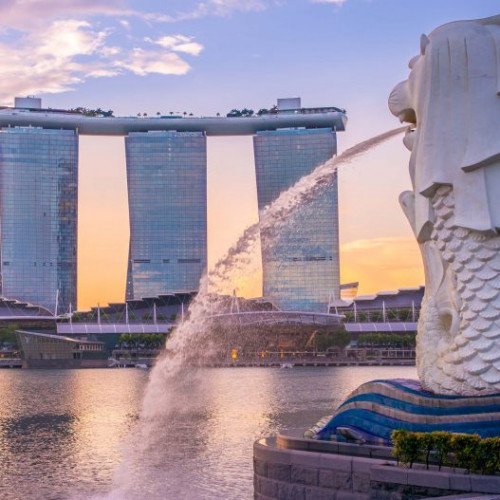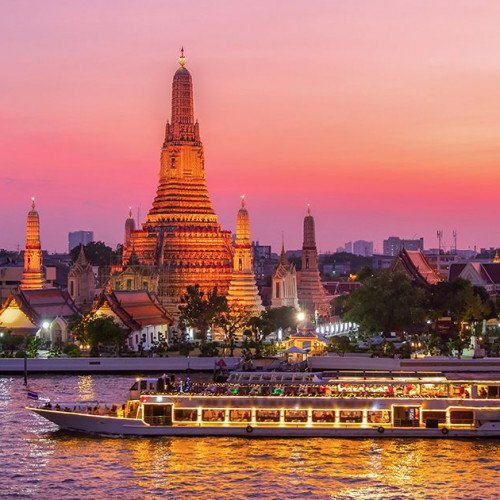Most vibrant country to visit in Asia: Thailand vs Singapore

Singapore
Singapore ( (listen)), officially the Republic of Singapore, is a sovereign island city-state in maritime Southeast Asia. It lies about one degree of latitude (137 kilometres or 85 miles) north of the equator, off the southern tip of the Malay Peninsula, bordering the Straits of Malacca to the west, the Riau Islands (Indonesia) to the south, and the South China Sea to the east. The country's territory is composed of one main island, 63 satellite islands and islets, and one outlying islet, the combined area of which has increased by 25% since the country's independence as a result of extensive land reclamation projects. It has the second greatest population density in the world. The country has almost 5.7 million residents, 61% (3.4 million) of whom are Singaporean citizens. There are four official languages of Singapore: English, Malay, Chinese and Tamil. English is the lingua franca. Multiracialism is enshrined in the constitution, and continues to shape national policies in education, housing, and politics. Although its history stretches back millennia, modern Singapore was founded in 1819 by Sir Stamford Raffles as a trading post of the British Empire. In 1867, the colonies in East Asia were reorganised and Singapore came under the direct control of Britain as part of the Straits Settlements. During the Second World War, Singapore was occupied by Japan in 1942, but returned to British control as a separate crown colony following Japan's surrender in 1945. Singapore gained self-governance in 1959, and in 1963 became part of the new federation of Malaysia, alongside Malaya, North Borneo, and Sarawak. Ideological differences led to Singapore being expelled from the federation two years later, becoming an independent country. After early years of turbulence and despite lacking natural resources and a hinterland, the nation rapidly developed to become one of the Four Asian Tigers based on external trade, becoming a highly developed country; it is ranked ninth on the UN Human Development Index, and has the second-highest GDP per capita (PPP) in the world. Singapore is the only country in Asia with an AAA sovereign rating from all major rating agencies. It is a major financial and shipping hub, consistently ranked the most expensive city to live in since 2013, and has been identified as a tax haven. Singapore is placed highly in key social indicators: education, healthcare, quality of life, personal safety and housing, with a home-ownership rate of 91%. Singaporeans enjoy one of the world's longest life expectancies, fastest Internet connection speeds and one of the lowest infant mortality rates in the world. Singapore is a unitary parliamentary republic with a Westminster system of unicameral parliamentary government. While elections are considered generally free, the government exercises significant control over politics and society, and the People's Action Party has ruled continuously since independence. One of the five founding members of ASEAN, Singapore is also the headquarters of the Asia-Pacific Economic Cooperation (APEC) Secretariat and Pacific Economic Cooperation Council (PECC) Secretariat, as well as many international conferences and events. Singapore is also a member of the United Nations, World Trade Organization, East Asia Summit, Non-Aligned Movement and the Commonwealth of Nations.
Statistics for this Xoptio

Thailand
Thailand, officially the Kingdom of Thailand and formerly known as Siam, is a country in Southeast Asia. Located at the centre of the Indochinese Peninsula, it is composed of 76 provinces spanning 513,120 square kilometres (198,120 sq mi), with a population of over 66 million people; Thailand is the world's 50th-largest country by land area and the 22nd-most-populous. The capital and largest city is Bangkok, a special administrative area. Thailand is bordered to the north by Myanmar and Laos, to the east by Laos and Cambodia, to the south by the Gulf of Thailand and Malaysia, and to the west by the Andaman Sea and the southern extremity of Myanmar. Its maritime boundaries include Vietnam in the Gulf of Thailand to the southeast, and Indonesia and India on the Andaman Sea to the southwest. Nominally, Thailand is a constitutional monarchy and parliamentary democracy; however, in recent history, its government has experienced multiple coups and periods of military dictatorships. Tai peoples migrated from southwestern China to mainland Southeast Asia from the 11th century; the oldest known mention of their presence in the region by the exonym Siamese dates to the 12th century. Various Indianised kingdoms such as the Mon kingdoms, Khmer Empire and Malay states ruled the region, competing with Thai states such as the Kingdoms of Ngoenyang, Sukhothai, Lan Na and Ayutthaya, which rivalled each other. Documented European contact began in 1511 with a Portuguese diplomatic mission to Ayutthaya, which became a regional power by the end of the 15th century. Ayutthaya reached its peak during cosmopolitan Narai's reign (1656–1688), gradually declining thereafter until being ultimately destroyed in the 1767 Burmese–Siamese War. Taksin (r. 1767–1782) quickly reunified the fragmented territory and established the short-lived Thonburi Kingdom. He was succeeded in 1782 by Buddha Yodfa Chulaloke (r. 1782–1809), the first monarch of the current Chakri dynasty. Throughout the era of Western imperialism in Asia, Siam remained the only nation in the region to avoid being colonized by foreign powers, although the Siamese government was often forced to cede both territory and trade concessions in unequal treaties. The Siamese system of government was centralized and transformed into modern unitary absolute monarchy in the reign of Chulalongkorn (r. 1868–1910). Siam joined World War I siding with the allies, a political decision to amend the unequal treaties. Following a bloodless revolution in 1932, Siam became a constitutional monarchy and changed its official name to "Thailand". Thailand was a satellite of Japan in World War II. In the late 1950s, a military coup under Field Marshal Sarit Thanarat revived the monarchy's historically influential role in politics. Thailand became a major ally of the United States, and played a key anti-communist role in the region as a member of the Southeast Asia Treaty Organization (SEATO). Apart from a brief period of parliamentary democracy in the mid-1970s, Thailand has periodically alternated between democracy and military rule. Since the 2000s, Thailand has been caught in a bitter political conflict between supporters and opponents of Thaksin Shinawatra, which culminated in two coups, most recently in 2014 and the establishment of its current and 20th constitution and faces the ongoing 2020 Thai protests. Thailand is a founding member of the Association of Southeast Asian Nations (ASEAN). Despite comparatively sporadic changes in leadership, it is considered a middle power in global affairs. With a high level of human development, the second-largest economy in Southeast Asia, and the 20th-largest in the world by PPP, Thailand is classified as a newly industrialized economy; manufacturing, agriculture, and tourism are leading sectors of the economy.